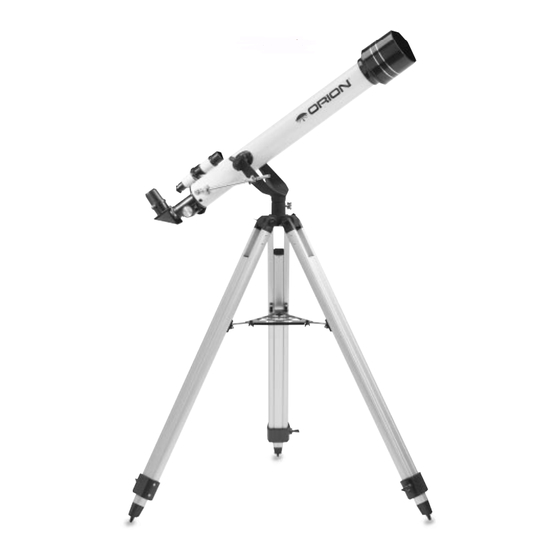Table of Contents
Advertisement
Quick Links
Advertisement
Table of Contents

Summary of Contents for ORION TELESCOPES & BINOCULARS Observer 60 AZ 9020
- Page 1 INSTRUCTION MANUAL Orion ® Observer 60 AZ ™ 60mm Altazimuth Refracting Telescope #9020 Customer Support (800) 676-1343 E-mail: support@telescope.com Corporate Offices (831) 763-7000 P.O. Box 1815, Santa Cruz, CA 95061 Providing Exceptional Consumer Optical Products Since 1975 IN 123 Rev. A 0799...
- Page 2 Optical tube Dew cap Objective lens Finder scope Finder scope bracket Finder scope focuser Altitude lock knob Eyepiece Yoke Azimuth lock knob Eyepiece lock thumbscrew Star diagonal Focuser draw tube Focusing knob Altitude micro-motion knob Altitude micro-motion rod Altitude micro-motion Tripod leg bolt lock knob Tripod leg...
-
Page 3: Table Of Contents
ongratulations on your purchase of a quality Orion telescope. Your new Observer 60 AZ Refractor is designed primarily for astronomical viewing, but can also be used for terrestrial observation (with the recommended addition of an image-erecting diagonal prism). If you have never used a telescope before, we would like to welcome you to amateur astronomy. Take some time to familiarize yourself with the night sky. -
Page 4: Parts List
Optical Tube The main body of the telescope, which houses 2. Attach the three tripod legs to the base of the yoke mount the optics. by lining up the holes in the leg with the holes in the base of the mount, then inserting a tripod leg bolt through. (The Rack-and-Pinion Focuser A type of focusing device that hinged accessory tray bracket on each leg should be fac- employs a grooved “rack”... -
Page 5: Using Your Telescope
pressure on the main telescope tube to recenter the object in as cold as possible. If it has to adjust to more than a 40° tem- the field of view, if it moved off center when you tightened the perature change, allow at least one hour. Make sure you are lock knobs. -
Page 6: Astronomical Viewing
Eyepiece Selection “Seeing” and Transparency Always start viewing with your lowest-power, widest-field Atmospheric conditions vary significantly from night to night. eyepiece. After you’ve located and looked at the object with a “Seeing” refers to the steadiness of the Earth’s atmosphere at low-power eyepiece, switch to a higher-power eyepiece and a given time. -
Page 7: Terrestrial Viewing
You can see a great number and variety of astronomical deep-sky objects are very faint, so it is important that you find objects with your Observer 60, including: an observing site well away from light pollution. Take plenty of time to let your eyes adjust to the darkness. Don’t expect The Moon these subjects to appear like the photographs you see in With its rocky, cratered surface, the Moon is one of the easiest... -
Page 8: Specifications
Cleaning the Optics 9. Specifications A small amount of dust or a few specks on the glass objec- Objective lens: 60mm-diameter (2.4") achromat, magnesium tive (main) lens will not affect the performance of the fluoride-coated telescope. If dust builds up, however, simply blow it off with a blower bulb, or lightly brush it off with a soft camel-hair brush.

















Need help?
Do you have a question about the Observer 60 AZ 9020 and is the answer not in the manual?
Questions and answers